Biking in Kandal, Cambodia


I did the half-day excursion from 9 to 2 pm through a company called Adventure Cambodia. The price was $29 and it included pick up and drop off, a ferry ride, lunch, water, and a tour of a silk weaving house.
We were picked up by our tour guide Khiem (pronounced Kim) at 9 o’clock and headed to the ferry. Once we were loaded, it was a short 10 to 15 minute ride across the Mekong to Kandal province. We were dropped off in a Vietnamese settlement along the Mekong, which consisted of a church in the middle of a pieced together shantytown. From there we hopped on our bikes and started our 12 km ride through the farmlands of Kandal.
We biked through the Vietnamese village before we found ourselves on a dirt road surrounded by silence, banana trees and fresh air. It was a complete 180 from the capital across the river. As we continued biking we saw cows, horses, donkeys, sesame fields, houses, empty plots of land for sale, and farmers.
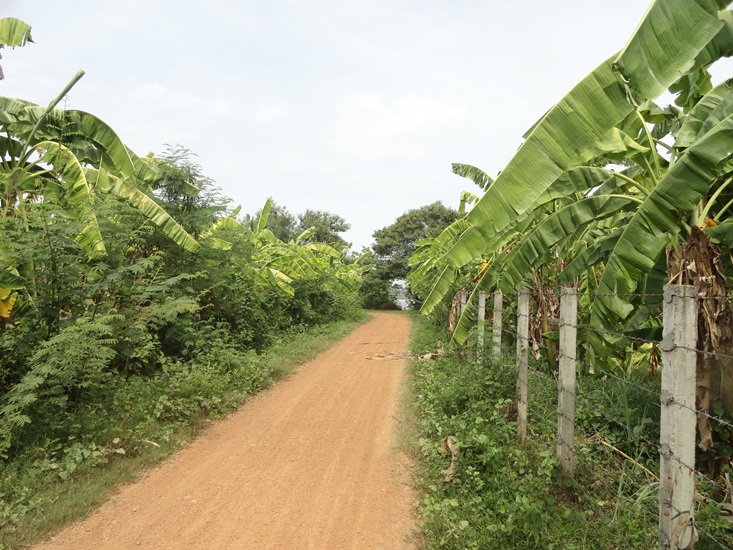
After about an hour of biking, we made it to our first destination, the silk weaving house.
After about an hour of biking, we made it to our first destination, the silk weaving house. A woman warmly greeted us with a tray of fresh fruit and water. We sat down, ate, talked and rested before exploring the small home where silk scarves, dresses, and table runners are hand made.
We walked by four looms with unfinished projects to see the silk worms making their silk cocoons. Our guide explained the silk worms’ life cycle and the process from cocoon to silk thread. The cocoons are boiled to make the thread. After the first boil the thread is still rough, so they boil them again to make it silkier. The longer they boil, the silkier the strands become.
Most of their dye is nature-based. For example they use Jack Fruit bark to make a light yellow color and banana leaves to make green. She explained that the natural dyes come out paler and for the bright colors, they have use chemicals.
To begin a pattern, the women first thread the silk through what looks like a long fine comb. This “comb” has over 500 teeth–each filled with a single thread of silk. This is what holds the pattern. We were led to a loom that had the most basic of patterns and watched a woman weave. Afterwards, we were allowed to take her place and try it out.
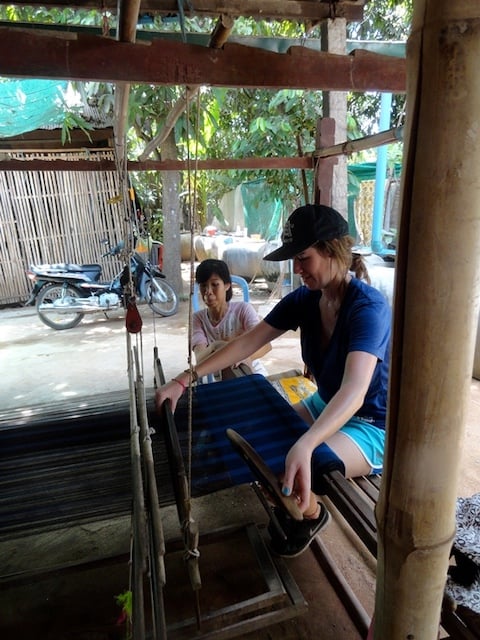
Under the loom, and similar to an old fashioned sewing machine, there are two pedals.
Under the loom, and similar to an old fashioned sewing machine, there are two pedals. The pedals controlled what looked like a stationary mobile that controlled the colors and the pattern that was being distributed. I also had what looked like a canoe on its side in my hand. This canoe was made of smooth polished wood and the inside held a spool of thread. On the loom there’s space that acts as a tunnel right next against the comb.
Every time you push on a pedal, you throw the canoe through the tunnel and then release your foot and take the comb and lightly slam it towards you. This pushes the thread from the canoe tightly into position to make the pattern flawless. Push the other pedal, throw the canoe again and lightly slam the comb. Keep repeating and you will start to see the pattern.
The first time I threw the canoe, it made it a little over half way through the tunnel. Our guide, a little annoyed, poked her fingers through the thread and pushed it to the other end. Then when it came time to slam the comb, I did it too gently underestimating the strength of the hundreds of silk strands. She looked at me and demonstrated how to do it properly. I was astounded by the strength.
Biking in Kandal, Cambodia
After we had the opportunity to weave we looked around at the other looms. I marveled at the patterns. I realized that every wedding, foreign order, or any other need of a Cambodian was met and made at the hand of a local. The complexity of some of the looms made me think about how much patience these women have.
These women weavers take their time. There was never moment in the hour and a half I was there that every loom was being worked on. Women worked for about 30 minutes, then walked away and took a break. These shops are homes, shomes if you will, and are run much more like homes than meet-the-demand-of-every-customer businesses.
Next to where we were waiting was a pagoda.
After admiring the looms, we shopped and then took off on our bikes, to explore more before lunch. We got on the main road and biked deeper into Kandal. In fact, we biked through wedding tents, waving and saying hi to children along the way. We arrived at the edge of a river where we waited for a different ferry to take us to an island across the river.
Next to where we were waiting was a pagoda. Khiem told us that this pagoda is home to a blessed pig. This pig’s hooves were different and resembled more a human than a pig, so the people gave it to the monks in the Pagoda. This pig doesn’t have a name and is only known as Big Pig. Estimates are that it weighs around 200 kilos. Because Big Pig is blessed, no one speaks of eating it.
We figured that the ferry would be a while so we went to find Big Pig. From a distance I thought the pig was a rock. As we got closer, I couldn’t believe it. There was this unbelievably HUGE pig lying, panting, and puffing in what looked like a dirt bed. I have never seen such a big pig.
After taking pictures we headed back to the river’s edge, where we bought rice cakes.
After taking pictures we headed back to the river’s edge, where we bought rice cakes. We inquired how much longer the ferry would be, and Khiem explained that sometimes the ferry waits until the students are out of school to come across the river. We decided that it was time for lunch and headed back to the weaving house.
In fact, we ate fried noodles with egg and after our long lunch, we said our thank yous and see you soons and headed back to beat the storm that was forming above us. We took a quicker route back on the main road, dropped off our bikes, headed to the ferry, crossed the Mekong and returned to Phnom Penh.
On our ferry ride back, one thing stood out to me. A man and woman who were my age were on a moto stacked with what looked like lemon grass, which barely left room for them. They got on the ferry, stayed on their moto for the ride, and got off in Phnom Penh. I never asked but I figured they were headed to a market to sell the lemon grass. It struck me how local and fresh everything is here.
I realized again that despite the chaos of Phnom Penh there is a system and it works beautifully. It reminds me of the loom, so many tiny pieces, all equally important, and together they make a beautiful pattern that is unbelievably strong.
Sums up Cambodia if you ask me.
Travel Tip #6
Tourist attractions are there for a reason. Some are really good to see, and you should see them, but don’t do only see those. Strike up a conversation with a local or an expat and get the scoop on what else is there to do that will allow you to see the country that the locals know–not just the one that is shown to us tourists.
Photos by Caitlin Werd.


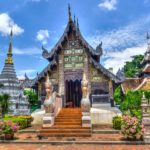
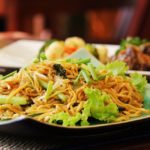
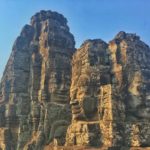


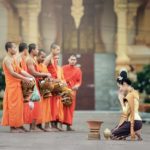
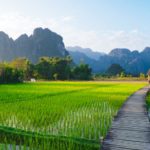
Interesting. I want to see a picture of the pig.